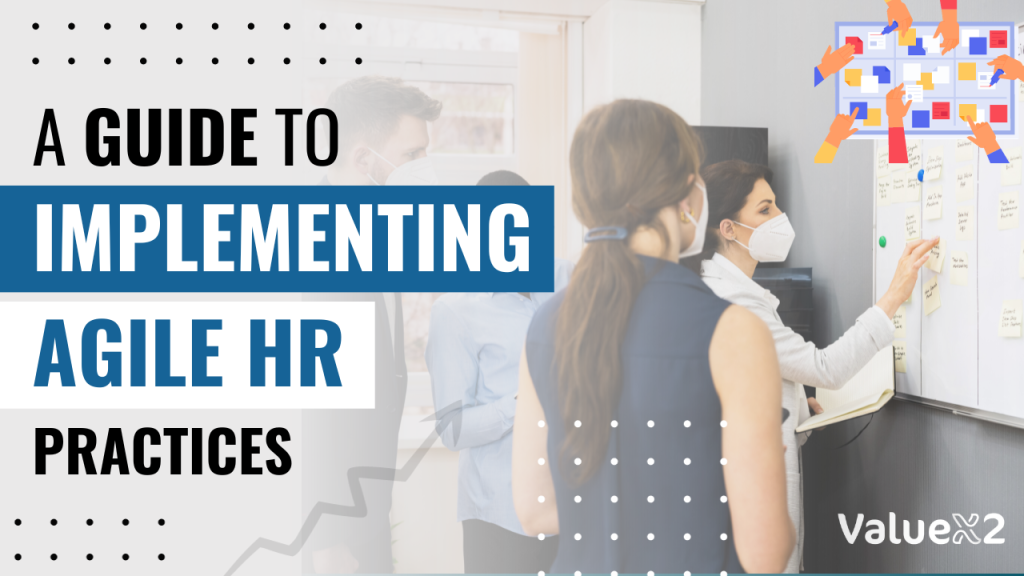Implementing Agile HR practices transforms workplaces. This guide provides insights and strategies to implement Agile HR practices for a more efficient and dynamic workplace.

Agile HR is an approach to human resources management that applies Agile principles and values to HR processes and practices. Agile HR emphasizes flexibility, collaboration, and continuous learning and improvement to meet the changing needs of businesses and employees. It focuses on delivering value to customers, both internal and external, by aligning HR practices with the organization’s goals and objectives. Agile HR is essential for businesses because it enables them to respond quickly and effectively to changing market conditions, customer needs, and technological advancements. It also promotes employee engagement and productivity, enhances innovation and creativity, and increases customer satisfaction. In this blog, we will explore Agile HR principles, benefits, implementation processes, challenges, and best practices.
5 Key Agile HR principles
Agile HR is a people-focused approach that emphasizes flexibility, adaptability, and continuous improvement in HR processes. It requires HR professionals to embrace the values of the Agile methodology and apply them to HR practices to better align with business goals. Here are the five core principles of Agile HR:
-
Continuous Feedback and Communication
Regular communication and feedback among employees, HR professionals, and other stakeholders enable teams to identify issues and quickly adjust course to address them.
-
Flexibility and Adaptability
Agile HR embraces change and responds quickly to evolving business needs, which requires HR professionals to be flexible and adaptable in their approach.
-
Collaboration and Teamwork
Effective collaboration among HR professionals, managers, and employees promotes teamwork and enhances productivity.
-
Customer-Centric Approach
Agile HR emphasizes the needs and expectations of customers and stakeholders, ensuring HR practices are aligned with business goals.
-
Continuous Learning and Improvement
Agile HR encourages learning and professional development to continuously improve HR practices and better serve the needs of the organization.
By embracing these principles, organizations can create a culture of innovation, flexibility, and collaboration that drives business success.
Agile HR Implementation Process
The Agile HR implementation process involves a series of steps that aim to transform traditional HR practices into agile and flexible processes that support the organization’s growth and success. This process can be summarized into five key stages: assessing the current HR processes and practices, identifying areas for improvement, building an Agile HR team, developing an Agile HR strategy and roadmap, and implementing and continuously refining the Agile HR practices.
Step 1:
Assessing the current HR processes and practices involves evaluating the existing HR framework to identify gaps and opportunities for improvement. This stage sets the foundation for the rest of the Agile HR implementation process.
Step 2:
Identifying areas for improvement and setting goals involves identifying specific areas of HR that require changes and setting realistic goals that align with the organization’s overall objectives.
Step 3:
Building an Agile HR team and defining roles and responsibilities involves forming a team of HR professionals who are committed to implementing Agile practices and defining their roles and responsibilities in the implementation process.
Step 4:
Developing an Agile HR strategy and roadmap involves creating a roadmap that outlines the specific steps and milestones that the Agile HR team will take to achieve their goals.
Step 5:
Implementing and continuously refining the Agile HR practices involves putting the Agile HR strategy into action, continuously evaluating its effectiveness, and refining it to ensure continuous improvement. The Agile HR team should prioritize feedback and collaboration, and use metrics to measure success and identify areas for improvement.
Challenges Faced by Agile HR in Implementation
Agile HR is a relatively new approach to human resource management that is designed to help organizations be more responsive and adaptable to change. While it has many benefits, implementing Agile HR can be challenging. In this section, we will discuss some of the key challenges that organizations may face when implementing Agile HR.
- Resistance to change
One of the biggest challenges of implementing Agile HR is resistance to change. Many employees may be comfortable with traditional HR practices and may be reluctant to adopt new approaches.
- Lack of understanding of Agile HR principles
Another challenge is the lack of understanding of Agile HR principles. Many HR professionals may not be familiar with Agile methodology, and may not understand how it can be applied to HR.
- Difficulty in aligning HR practices with Agile values
It can also be challenging to align traditional HR practices with Agile values. For example, performance appraisals may be at odds with the Agile principle of continuous feedback.
- Lack of support from senior management
Implementing Agile HR may be difficult without support from senior management. Without leadership buy-in, it can be challenging to get the resources and support necessary for a successful implementation.
Best practices for Agile HR implementation
Agile HR is a relatively new concept that is rapidly gaining popularity among businesses worldwide. It is an approach to human resource management that emphasizes flexibility, collaboration, and continuous learning and improvement. Implementing Agile HR practices can have significant benefits for organizations, including faster decision-making, improved employee engagement and productivity, increased innovation, and better alignment with business goals. However, to realize these benefits, businesses must follow best practices for Agile HR implementation.
-
Educate and train HR professionals on Agile principles
The first best practice for implementing Agile HR is to educate and train HR professionals on Agile principles. Agile HR is a mindset that requires a fundamental shift in the way HR professionals approach their work. HR professionals must understand the principles of Agile, such as continuous learning, flexibility, and collaboration, to effectively implement Agile HR practices. Providing training and education to HR professionals can help them understand the benefits of Agile HR and how to apply Agile principles to their work.
-
Involve employees in the Agile HR implementation process
Another critical best practice for Agile HR implementation is to involve employees in the process. Agile HR is a collaborative approach that emphasizes teamwork and open communication. Involving employees in the Agile HR implementation process can help ensure that their needs are taken into account and that they feel heard and valued. Employee involvement can also increase buy-in and support for Agile HR practices, making the implementation process smoother and more effective.
-
Establish metrics and track progress
To measure the effectiveness of Agile HR practices, businesses must establish metrics and track progress. Metrics can help HR professionals determine whether Agile HR practices are achieving their intended outcomes, such as increased employee engagement and productivity. Metrics can also help HR professionals identify areas for improvement and make necessary adjustments to Agile HR practices.
-
Continuously evaluate and adapt the Agile HR practices
Agile HR is a continuous learning and improvement process. HR professionals must continuously evaluate and adapt Agile HR practices to ensure that they are meeting the needs of the organization and its employees. Continuously evaluating and adapting Agile HR practices can help ensure that they remain relevant and effective, even as the business environment changes.
-
Communicate the benefits of Agile HR to stakeholders
Communicating the benefits of Agile HR to stakeholders is an essential best practice for Agile HR implementation. Stakeholders, including senior management, employees, and customers, need to understand the benefits of Agile HR and how it can help the organization achieve its goals. Communicating the benefits of Agile HR can increase support for the implementation process and help ensure its success.
So, Implementing Agile HR practices can have significant benefits for businesses. However, to realize these benefits, businesses must follow best practices for Agile HR implementation. These best practices include educating and training HR professionals on Agile principles, involving employees in the implementation process, establishing metrics and tracking progress, continuously evaluating and adapting Agile HR practices, and communicating the benefits of Agile HR to stakeholders. By following these best practices, businesses can successfully implement Agile HR practices and improve their overall performance and competitiveness.
Epilogue
Agile HR is a crucial approach that businesses can adopt to remain competitive and responsive to their employees’ needs. Agile HR principles, such as continuous feedback, collaboration, and flexibility, can improve decision-making, engagement, productivity, innovation, and customer satisfaction. Implementing Agile HR practices may present challenges such as resistance to change, lack of understanding, and difficulty in alignment, but following best practices such as educating HR professionals, involving employees, establishing metrics, and continuous evaluation can ensure successful implementation.
At ValueX2, we provide education about Agility in HR to help businesses implement Agile HR practices that can transform their HR operations and achieve their strategic goals. Our expert trainers can help assess your current HR processes and practices, identify areas for improvement, develop an Agile HR strategy, and provide ongoing support and guidance throughout the implementation process. Contact us today to learn more about how we can help you implement Agile HR and achieve better business outcomes.
FAQs on Agile HR Implementation
Q1. What is Agile HR, and why does modern business need it?
A: Agile HR stands for the same principles that Agile applies to innovation, such as flexibility, collaboration, and continuous improvement applied to HR processes. It is crucial for modern businesses because it enables faster adaptation to change, enhances employee engagement, boosts productivity, and allows HR to be aligned with organizational goals towards sustainability and success.
Q2. How does Agile HR practice positively impact workplace dynamics?
A: Agile HR ensures that systems are transparent, continuously in touch with feedback, and highly customer-centric, resulting in better teamwork across teams. It enhances the dynamics of the workplace by making the roles of employees supportive of their business objectives, creating an environment of trust, engagement, and innovation.
Q3: What are the major principles of Agile HR?
A: There are five core principles for Agile HR, namely:
- Continuous communication and feedback.
- Flexibility and adaptability.
- Collaboration and teamwork.
- A customer-centric approach.
- Continuous learning and improvement.
These principles will help empower HR to drive organizational agility and foster a more dynamic workplace.
Q4: How do you begin implementing Agile HR in an organization?
A: Start with an assessment of current HR processes to identify areas for improvement, set goals on aspects that need correction, and create a dedicated Agile HR team. Develop a roadmap for aligning HR practices with Agile principles and continuously refine them with feedback and metrics.
Q5: What are some common challenges to implementing Agile HR practices?
A: Challenges comprise of:
- Resistance from the employees and management
- Limited understanding of Agile among the HR teams.
- Misperceptions of traditionalistic HR practices concerning Agile.
- Not much support from the senior leadership
- Ensuring training, communication, and also leadership buy-in must address the same for a smoother transition.
Q6: How might Agile HR help employees?
A: Agile HR benefits the employees by promoting a culture of feedback, collaboration, and learning. Skill development opportunity; employees are considered an integral part of the decision-making process. An agile and supportive workplace is witnessed.
Q7: What tools or frameworks should be used for the implementation of Agile HR?
A: Tools like Kanban boards, performance management software, and collaboration platforms like Trello or Asana support Agile HR practices. Frameworks such as Scrum or SAFe (Scaled Agile Framework) can also be tailored to HR processes to enhance efficiency.
Q8: How do you measure the success of Agile HR practices?
A: Metrics considered are employee engagement scores, productivity levels, rates of employee turnover, and time to hire. Additionally, regular feedback loops and performance reviews also guide the effectiveness of Agile HR practices.
Q9: What role can Agile HR play in quickly reacting to change in an organization?
A: Agile HR fosters flexibility and responsiveness, allowing an agile firm to quickly adapt to changes. Agile HR teams focus on short-term goals with iterative planning and open channels of communication meant for effective response to changing needs.
Q10: How does ValueX2 help implement Agile HR?
A: ValueX2 helps through expert guidance in transforming the process of HR through Agile principles. We have been long-time partners with ICAgile, which highlights our credibility. Coming to our services include an assessment of the current practices, identification of the improvement areas, development of strategic roadmaps, and conducting training programs to ensure perfect implementation and measurable outcomes.
Ready to transform your HR operations? Contact ValueX2 today!






